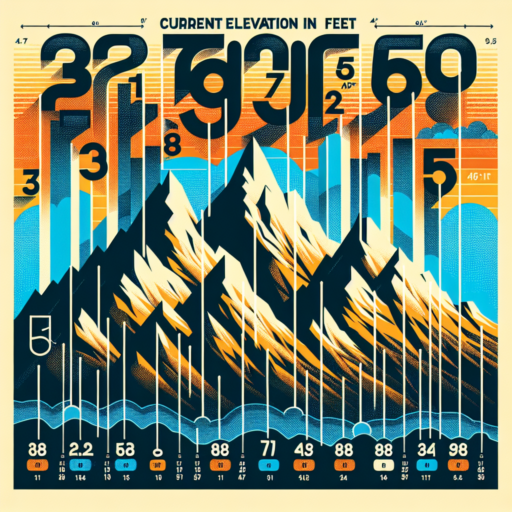Understanding Altitude: What Does It Mean?
Altitude, often related to the height of a location in relation to sea level or the earth’s surface, is a fundamental concept in various fields such as aviation, geography, and even everyday life. When we talk about altitude, we are essentially discussing the vertical dimension that quantifies how high or low a position is situated. The understanding of altitude is not only critical for pilots navigating through the skies but also for hikers, engineers, and meteorologists who rely on accurate altitude information for a range of applications.
How Is Altitude Measured?
There are several methods to measure altitude, but the most common is through the use of barometric pressure. As one ascends higher above sea level, the atmospheric pressure decreases. This relationship between altitude and pressure allows for the use of barometers and altimeters to obtain accurate altitude readings. Additionally, modern technology has introduced GPS-based systems that provide altitude information by triangulating positions with satellites, offering an alternative to traditional pressure-based measurements.
The Importance of Understanding Altitude
Comprehending the concept of altitude is essential for safety in aviation, where accurate altitude readings ensure that aircraft maintain safe distances from the ground and each other. Moreover, altitude affects environmental conditions and weather patterns, making it a crucial factor for climate researchers and forecasters. In mountainous areas, understanding altitude can help hikers prepare for changes in oxygen levels and temperature, highlighting its significance in both professional and recreational activities.
How to Determine Your Current Altitude
Determining your current altitude is crucial for various activities such as hiking, mountaineering, and even for certain professional tasks. There are multiple approaches one can take to find out their altitude above sea level, each varying in precision and equipment required.
Using a Barometric Altimeter
One of the most common methods to determine your altitude is through the use of a barometric altimeter. This device measures the atmospheric pressure and converts this measurement into an approximation of your altitude. It’s important to note that the accuracy of a barometric altimeter can be influenced by changing weather conditions. Therefore, regular calibration is necessary for precise readings.
Utilizing GPS Technology
In the modern era, GPS devices have become a popular tool for measuring altitude. Whether it’s a standalone GPS unit or a feature within your smartphone, these devices calculate your position and altitude by triangulating your location relative to satellites. While GPS technology offers a convenient way to determine your altitude, it’s essential to understand that its accuracy can vary depending on the satellite coverage and the device’s quality.
Additionally, certain smartphone apps and watches have built-in features for altitude measurement. These methods combine various data sources, including barometric pressure and GPS, to provide a more comprehensive estimate of your altitude. In doing so, they aim to enhance the reliability of the altitude reading.
The Role of Technology in Measuring Altitude
Understanding the role of technology in measuring altitude reveals a fascinating journey from ancient methods to today’s sophisticated tools. Technological advancements have not only enhanced the accuracy of altitude measurements but have also made it possible to gather data from remote and previously inaccessible locations. In this exploration, we focus on the transformative impact of digital technology in elevating our capabilities to measure heights with unprecedented precision.
Evolution of Altitude Measurement Technologies
Historically, determining altitude was a task reliant on basic physical instruments and the observation of natural phenomena. This changed with the invention of the barometer, enabling altitude estimation based on atmospheric pressure. However, the advent of the Global Positioning System (GPS) marked a quantum leap, offering real-time altitude data with remarkable accuracy. Today’s technology employs a variety of sensors and satellite data, enabling not just pilots and hikers but also scientists and geographers to obtain precise altitude information.
Impact on Various Fields
The implications of advanced altitude-measurement technology span multiple domains. In aviation, it ensures the safety and efficiency of flights by providing accurate altitude data crucial for navigation and air traffic control. Climatology benefits from detailed topographical data, enabling better predictions of weather patterns and climate change impacts. Furthermore, advancements in technology have revolutionized mountaineering and hiking, making GPS devices indispensable for safe navigation in challenging terrains.
Altitude and Its Effects on the Human Body
Exploring the impact of altitude on the human body unveils a complex interaction between our physiology and the environment. At higher elevations, the air becomes less dense, leading to a decrease in oxygen availability. This scarcity of oxygen can trigger a series of adaptations and physiological responses aimed at optimizing oxygen uptake and utilization.
One of the initial responses to high altitude is increased heart rate and ventilation. This natural adjustment aims to compensate for reduced oxygen levels by delivering more oxygen to the muscles and vital organs. However, these changes also increase the workload on the heart and lungs, which can present challenges for those with pre-existing cardiac or pulmonary conditions.
Acute Mountain Sickness (AMS)
As individuals ascend to higher altitudes, they may experience Acute Mountain Sickness (AMS), a condition characterized by symptoms such as headaches, nausea, fatigue, and dizziness. AMS occurs as the body struggles to adapt to sudden changes in altitude and the resulting oxygen deficiency. It’s crucial for mountaineers and high-altitude enthusiasts to be aware of AMS signs and take preventive steps, such as gradual ascent and adequate acclimatization.
Comparing Sea Level and Present Altitude: What’s the Difference?
When we talk about the distinction between sea level and present altitude, it’s crucial to understand the fundamental differences that set them apart. Sea level is a universal measurement used as a base to determine the height or depth of Earth’s geographical features, relative to the average height of the ocean’s surface. On the other hand, present altitude refers to the height of a specific location above sea level at any given point in time. This distinction is vital for a myriad of scientific, navigational, and environmental studies.
The concept of sea level serves as a standardized benchmark, enabling us to compare altitudes across the globe consistently. It is important to note, however, that sea level is not uniform worldwide due to factors such as gravitational forces, ocean currents, and atmospheric pressure. These variations mean that when we discuss present altitude, we are referring to a specific measurement above sea level that can fluctuate based on the geographic location being measured.
Understanding the difference between sea level and present altitude is crucial for activities such as aviation, where accurate altitude readings are essential for safe flight operations. In geographical mapping and construction, knowing the present altitude helps in planning and executing projects with precision. As sea levels continue to change due to climatic shifts, grasping the distinction and its implications becomes increasingly important for predicting future impacts on coastal and low-lying areas.
Practical Applications of Knowing Your Current Altitude
Understanding your current altitude has a wide array of practical applications that can impact various aspects of daily life, as well as specialized fields. This knowledge is not just for adventurers and pilots; it’s beneficial for agriculture, construction, and even your health. With the advancement of technology, accessing this information has become easier and more accurate, integrating seamlessly into our everyday activities.
Navigating and Trekking
For outdoor enthusiasts, knowing your altitude is crucial for navigation and safety. Whether you’re hiking, mountain biking, or skiing, altitude information can help you assess the difficulty of a trail, prepare for weather changes, and recognize your location in case of an emergency. Modern GPS devices and smartphones now offer real-time altitude data, making outdoor adventures safer and more enjoyable.
Health and Physical Activity
Altitude can significantly affect your health and physical performance. For athletes training at high elevations, understanding altitude changes is vital for acclimatization and avoiding altitude sickness. Moreover, for individuals with certain health conditions, like heart disease, being aware of high altitudes is essential for making informed decisions about physical activity levels and necessary precautions.
Furthermore, the applications of knowing your altitude extend into the realms of agriculture, where it influences irrigation needs and crop viability, and urban planning, where it helps in assessing flood risks and designing efficient drainage systems. As we continue to find innovative ways to utilize altitude data, its importance in our daily lives and various professional fields becomes increasingly evident.
No se han encontrado productos.
Common Altitude Measurements and Terms Explained
Understanding the various terms and measurements associated with altitude is crucial, whether you’re a passionate hiker, a budding pilot, or just curious about geography. Altitude refers to the height of an object above a specific reference point, typically sea level. Different fields use different terms and units to discuss altitude, making it a multifaceted topic. In this segment, we’ll demystify some of the most common altitude measurements and terms.
Sea Level: The Base Reference
When discussing altitude, sea level is often the starting point. It’s the average height of the ocean’s surface and serves as a universal baseline for measuring elevation and depth. From the majestic Mount Everest to the depths of the Mariana Trench, all measurements stand relative to sea level, providing a consistent frame of reference for scientists, geographers, and adventurers alike.
Elevation vs. Altitude: Understanding the Difference
It’s easy to use the terms elevation and altitude interchangeably, but they delineate distinct concepts. Elevation is the height of a point on the Earth’s surface above sea level, frequently used to describe the height of landforms such as mountains and hills. On the other hand, altitude refers to the height of an object in the air above the Earth’s surface, crucial for aviation and meteorology. Grasping the difference enriches one’s comprehension of geographical and atmospheric studies.
Flight Altitude Terms
In the realm of aviation, understanding altitude is vital for safety and navigation. Pilots refer to absolute altitude as the height above the ground directly below, critical for avoiding terrain and obstacles during takeoff and landing. Cruising altitude, on the other hand, is the stable height a plane maintains during the majority of its flight, usually measured in feet above sea level (ASL). Recognizing these terms helps in appreciating the complexity and precision of flight operations.
Navigating Altitude in Aviation: Basics for Beginners
Understanding the fundamentals of altitude is paramount for any aspiring pilot or aviation enthusiast. Altitude, in its essence, refers to the vertical distance measured from a specific reference point, usually sea level, to an object in the air such as an aircraft. Grasping the concept of altitude is crucial for safe and efficient navigation through the vast skies.
In the realm of aviation, altitude is categorized into different types based on the reference point used. Notably, Pilots should be familiar with terms like «absolute altitude,» «true altitude,» «indicated altitude,» and «pressure altitude.» Each type serves a unique purpose and is used in different scenarios of flight planning and operation. For instance, indicated altitude is what you see on your altimeter in the cockpit, and it’s vital for decision-making during flight.
Key Altitude Types Explained
- Absolute Altitude: The vertical distance of the aircraft above the ground level. Critical for avoiding terrain and obstacles.
- True Altitude: The actual height of the aircraft above sea level. It’s important for navigating through different airspaces.
- Indicated Altitude: What’s shown on the altimeter. It’s primarily used under instrument flight rules (IFR).
- Pressure Altitude: The height above the standard datum plane, a crucial factor for flight levels and air traffic control.
While mastering the concepts of altitude in aviation might seem daunting at first, it lays a strong foundation for advanced pilating techniques. Beginners are encouraged to delve deep into these altitude types and understand the operational procedures and regulations surrounding them. Such knowledge not only enhances safety but also significantly improves the overall flying experience.
Exploring the Earth: The Highest and Lowest Points
The Earth is a planet of extremes, from soaring mountain peaks that pierce the sky to deep ocean trenches that plunge into the planet’s darkest depths. When we talk about exploring the Earth’s highest and lowest points, we’re not only discussing geographical records; we’re delving into environments that challenge the limits of human exploration and scientific understanding. These places, almost alien in their extremity, beckon adventurers and scientists alike to uncover the secrets they hold.
The Summit of Mount Everest: The Peak of the World
The title of the highest point on Earth belongs to Mount Everest, part of the Himalaya range in Asia. Towering at an astonishing height of 29,029 feet (8,848 meters), Everest is the ultimate challenge for mountaineers. However, its significance goes beyond adventure. Scientifically, it offers invaluable insights into geology, weather patterns, and the impacts of climate change at extreme altitudes.
The Mariana Trench: Descending to the Deepest Depths
Conversely, the Mariana Trench holds the title for the Earth’s lowest accessible point. Located in the western Pacific Ocean, this colossal underwater canyon reaches a maximum known depth of about 36,070 feet (10,994 meters). The trench is not just an underwater marvel; it’s a hotspot for research on deep-sea ecosystems, extreme pressure conditions, and the mysteries of life in one of the planet’s most inhospitable environments.
Future Trends in Altitude Measurement and Technology
The world of altitude measurement and technology is on the brink of a transformative era, with new advancements promising to redefine how we understand our vertical environment. As we push the boundaries of exploration, from the deepest oceans to the farthest reaches of space, accurate and efficient altitude measurement has never been more crucial. The driving forces behind this evolution include advances in sensor technology, integration of artificial intelligence (AI), and the increasing demand for UAV (Unmanned Aerial Vehicle) operations.
Advancements in Sensor Technology
New generations of altimeters, which are crucial for determining altitude, are becoming more precise and reliable. These improvements are largely fueled by developments in pressure-based sensors and radar technology. Pressure-based sensors are now able to account for variabilities caused by temperature and weather conditions, making them more versatile across different environments. Similarly, radar altimeters have seen significant enhancements, offering better surface detection capabilities, which is especially beneficial for aerial and space applications.
Integration of Artificial Intelligence
Artificial intelligence is set to play a pivotal role in the future of altitude measurement, promising to bring about a leap in both accuracy and processing speed. AI algorithms are being developed to predict and compensate for potential errors in real-time, a feature that was unimaginable a few years ago. This opens up new possibilities for autonomous vehicles and drones, where precise altitude data is paramount. Furthermore, AI can significantly improve the interpretation of data collected from complex terrains, such as urban canyons or mountain ranges.
The Rise of UAVs in Altitude Measurement
The proliferation of UAVs has opened up new avenues for altitude measurement, offering a flexible and cost-effective solution for gathering high-resolution data. Drones equipped with advanced altimeters can navigate challenging landscapes, providing accurate measurements in areas that are otherwise inaccessible. This capability is invaluable for a wide range of applications, from geological surveys and disaster management to construction and agriculture. As UAV technology continues to evolve, we can anticipate even greater contributions to the field of altitude measurement.




